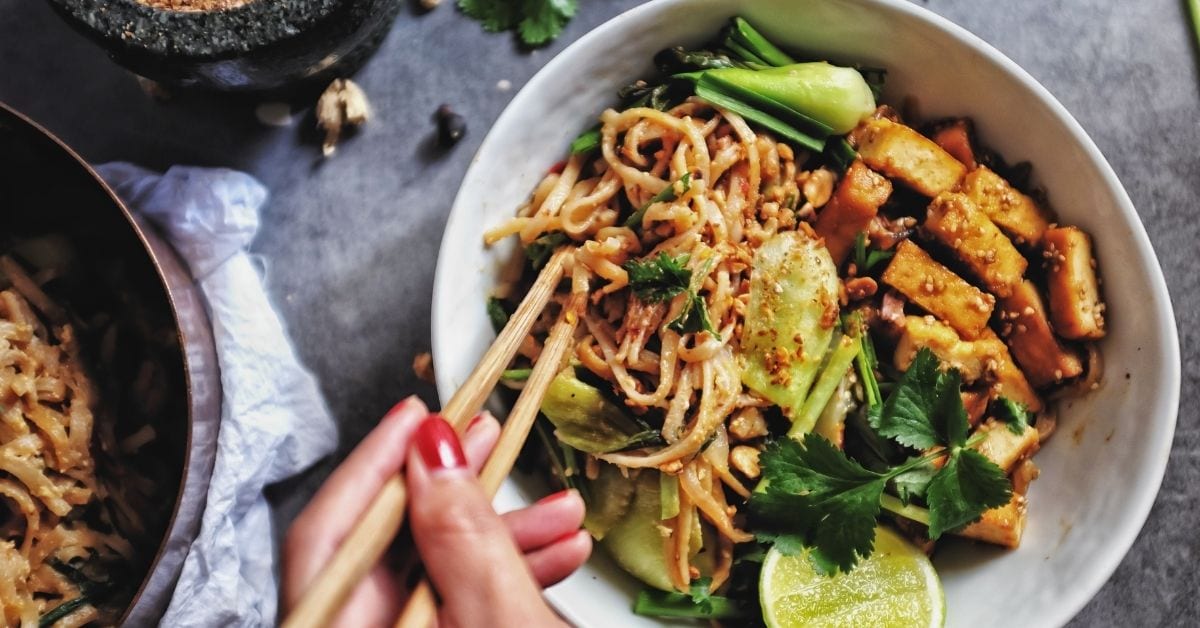Embark on a culinary adventure through the vibrant world of Thai vegetarian cuisine! This collection unveils a tantalizing array of spicy recipes, each bursting with fresh herbs, aromatic spices, and a delightful balance of sweet, sour, salty, and spicy flavors. From the fiery depths of a red curry to the fragrant embrace of a green curry, these dishes are designed to ignite your taste buds and transport you to the bustling street food markets of Thailand. Prepare to discover the secrets behind creating authentic Thai vegetarian dishes, mastering stir-fry techniques, and exploring the diverse world of Thai chili pastes and sauces. Get ready to create culinary masterpieces that will leave you craving more!
We’ll explore popular dishes, offering variations to suit different spice preferences and dietary needs. Detailed step-by-step instructions, along with insightful tips and techniques, ensure even novice cooks can achieve restaurant-quality results. Learn to balance flavors perfectly, prepare vegetables to retain their vibrant colors and textures, and discover creative serving suggestions and garnishes to elevate your culinary creations. Get ready to unleash your inner chef and impress your friends and family with the authentic tastes of Thailand.
Spicy Thai Vegetarian Stir-Fry Techniques
Mastering the art of Thai vegetarian stir-fries hinges on achieving that perfect balance of vibrant flavors and crisp-tender vegetables. The key lies in understanding the interplay of heat, technique, and the right ingredients. This section will guide you through the essential techniques to create stir-fries that are both visually stunning and incredibly delicious.
Stir-frying vegetables requires a swift and precise approach to retain their natural texture and color. High heat is paramount; it creates a quick sear that locks in the vegetables’ juices, resulting in a delightful crunch rather than a soggy mess. A wok, with its sloped sides and wide base, is traditionally preferred for its superior heat distribution and efficient tossing capabilities, allowing for even cooking. However, a large, heavy-bottomed skillet can also achieve excellent results. The crucial element is maintaining a consistently high temperature throughout the cooking process.
High Heat and the Importance of Wok Hei
The intense heat of a wok or large skillet is essential for achieving that coveted “wok hei,” a smoky, slightly charred flavor characteristic of authentic stir-fries. Imagine the vibrant scene: oil shimmering and almost smoking in the wok, vegetables tossed with a flourish, releasing their aromatic essence into the air. This intense heat quickly sears the vegetables’ surfaces, creating a delightful contrast between the crisp exterior and tender interior. Using a wok allows for more efficient tossing, ensuring that every piece receives equal exposure to the heat and prevents sticking or uneven cooking. Properly managing the heat, by adjusting the flame as needed, is crucial to prevent burning and maintain the desired level of crispness.
Stir-Frying Vegetables for Optimal Texture
To achieve that perfect balance of crisp-tender vegetables, start by preparing them appropriately. Cut vegetables into uniformly sized pieces to ensure even cooking. Add vegetables in order of their cooking time, starting with those that require longer cooking times, such as root vegetables, and finishing with quick-cooking greens. Continuous and rapid tossing is key to preventing sticking and ensuring even heat distribution. Overcrowding the wok will lower the temperature and lead to steaming rather than stir-frying, resulting in soggy vegetables. Work in batches if necessary to maintain the high heat. The ideal stir-fried vegetable should possess a slight char, a vibrant color, and a satisfying crunch.
Three Stir-Fry Sauce Recipes
The success of any stir-fry lies in its sauce. Here are three distinct sauce recipes that showcase the versatility of Thai flavors, ranging from mild to intensely spicy.
Mild Sweet Chili Sauce:
This sauce offers a balanced sweetness and subtle heat, perfect for those who prefer a milder flavor profile. Imagine the vibrant crimson hue, glistening with a delicate sheen. The sweet chili sauce provides a gentle warmth that complements the crisp vegetables without overpowering their natural flavors.
Ingredients: 1/4 cup sweet chili sauce, 2 tablespoons rice vinegar, 1 tablespoon soy sauce (or tamari for gluten-free), 1 teaspoon sesame oil.
Medium Spicy Peanut Sauce:
This sauce delivers a rich, nutty flavor with a satisfying kick of spice. Picture a creamy, dark brown sauce, punctuated by flecks of red chili. The peanut butter provides a luxurious texture and depth of flavor, while the chili adds a welcome warmth that tantalizes the taste buds.
Ingredients: 1/4 cup peanut butter (smooth or crunchy), 2 tablespoons soy sauce (or tamari), 2 tablespoons rice vinegar, 1 tablespoon lime juice, 1-2 tablespoons sriracha (adjust to taste), 1 teaspoon sesame oil.
Fiery Ginger-Garlic Sauce:
This sauce is for those who love a bold, fiery flavor. Envision a bright, vibrant sauce, its deep orange color hinting at the intense ginger and garlic flavors. The intense heat will leave a pleasant lingering warmth, a testament to the potent combination of chili and aromatic spices.
Ingredients: 2 tablespoons ginger paste, 2 tablespoons garlic paste, 3-4 tablespoons sriracha (adjust to taste), 2 tablespoons soy sauce (or tamari), 1 tablespoon lime juice, 1 teaspoon brown sugar.
Exploring Different Chili Pastes and Sauces
The vibrant tapestry of Thai cuisine is inextricably linked to its diverse array of chili pastes and sauces. These fiery condiments, ranging in heat level and flavor profile, are the key to unlocking the authentic taste of Thailand. Understanding their nuances is crucial for crafting truly delicious and authentic vegetarian Thai dishes. This section will delve into the characteristics of different chili pastes and demonstrate how to create a simple yet effective spicy Thai sauce.
Thai Chili Paste Variations
Three prominent types of Thai chili paste—green, red, and yellow—offer distinct flavor profiles and heat intensities. Green chili paste, often featuring a vibrant green hue from bird’s eye chilies, possesses a bright, herbaceous quality, with a fresh, slightly sweet undertone balanced by a potent heat. Red chili paste, typically made with dried chilies, boasts a richer, more complex flavor profile, often with hints of garlic, shrimp paste (omitted for vegetarian versions), and lemongrass. Its heat is generally more intense and lingering than green paste. Yellow chili paste, a less common but equally flavorful option, combines the freshness of green chilies with the depth of red, resulting in a balanced flavor profile and moderate heat. The intensity of each paste is influenced by the type and quantity of chilies used, as well as other added ingredients. A visual representation would show the varying colors and textures: the green paste appearing smooth and vibrant, the red paste slightly coarser with a deeper, reddish-brown tone, and the yellow paste a brighter, more golden yellow.
Creating a Simple Spicy Thai Sauce
A versatile spicy Thai sauce can be easily made using readily available ingredients. The base typically consists of a combination of chili paste (choose your preferred type based on desired heat level), fish sauce (or a vegetarian substitute like soy sauce or mushroom seasoning for a vegetarian version), lime juice, sugar, and garlic. The precise ratio of ingredients can be adjusted to personal preference, creating a sauce ranging from subtly spicy to intensely fiery. For example, a balanced sauce might use two tablespoons of green chili paste, one tablespoon of soy sauce, one tablespoon of lime juice, one teaspoon of sugar, and one minced garlic clove. The resulting sauce would possess a vibrant green hue, a lively aroma, and a balance of sweet, sour, salty, and spicy flavors. The visual would show a smooth, vibrant sauce, perhaps with flecks of garlic visible.
Comparison of Commercially Available Thai Chili Sauces
Several commercially available Thai chili sauces provide convenient options for adding spice to your dishes. The following table compares three popular brands, highlighting their key ingredients and heat levels (note that heat levels are subjective and can vary based on individual spice tolerance):
| Brand | Key Ingredients | Heat Level (1-5, 5 being hottest) | Flavor Profile |
|---|---|---|---|
| Sriracha | Chili, sugar, vinegar, garlic, salt | 3 | Sweet, tangy, garlicky |
| Mae Ploy Sweet Chili Sauce | Chili, sugar, vinegar, garlic, salt | 2 | Sweet, mild, slightly tangy |
| Prik Nam Pla | Chili, fish sauce (or vegetarian alternative), lime juice, sugar | 4 | Spicy, sour, salty, umami |
Serving Suggestions and Garnishes

Elevating your spicy Thai vegetarian feast goes beyond the masterful stir-fry techniques. The right serving suggestions and garnishes transform a delicious meal into a truly memorable culinary experience, enhancing both the visual appeal and the overall enjoyment. Consider the balance of flavors and textures to create a harmonious and satisfying dining experience.
Serving suggestions and garnishes are crucial for completing the spicy Thai vegetarian experience. The right accompaniments can enhance the flavors, textures, and overall presentation of your dish, creating a balanced and satisfying meal.
Creative Serving Suggestions
Five creative serving suggestions enhance the spicy Thai vegetarian experience by offering textural and flavor contrasts. These pairings provide a well-rounded meal, mitigating the intensity of the spice while complementing the rich flavors of the stir-fry.
- Spicy Thai Stir-Fry with Coconut Rice and Mango Salsa: The sweetness of the mango salsa cuts through the heat of the stir-fry, while the fluffy coconut rice provides a creamy counterpoint to the vibrant vegetables.
- Spicy Tofu Scramble with Steamed Jasmine Rice and Pickled Ginger: The tangy pickled ginger offers a refreshing contrast to the richness of the tofu scramble, and the fragrant jasmine rice provides a neutral base.
- Spicy Green Curry with Crispy Eggplant and Sesame Seed Crackers: The crispy eggplant adds a delightful textural contrast, while the sesame seed crackers provide a savory crunch that complements the creamy curry.
- Spicy Peanut Noodles with Fresh Spring Rolls and a Side of Thai Iced Tea: The refreshing spring rolls offer a lighter counterpoint to the richness of the peanut noodles, while the sweet and subtly spiced Thai iced tea perfectly complements the meal.
- Spicy Pineapple Fried Rice with a Side Salad and a Glass of Sparkling Water: The vibrant pineapple fried rice is balanced by the crispness of the side salad, and the sparkling water provides a light and refreshing accompaniment that cleanses the palate.
Garnishes to Enhance Visual Appeal and Flavor
Five garnishes significantly enhance the visual and gustatory experience of spicy Thai vegetarian dishes. These additions provide a final touch of elegance and intensify the sensory experience.
- Fresh Herbs: A vibrant sprinkle of chopped cilantro, Thai basil, and mint adds a burst of freshness and aromatic complexity, their bright green hues contrasting beautifully against the rich colors of the stir-fry.
- Toasted Nuts: A scattering of toasted peanuts, cashews, or macadamia nuts provides a delightful crunch and a nutty depth of flavor, adding a textural and taste dimension.
- Lime Wedges: A few wedges of bright lime offer a zesty acidity that cuts through the richness of the dish, adding a refreshing counterpoint to the heat and enhancing the overall flavor profile. The vibrant green and yellow hues add visual interest.
- Fried Shallots: Crispy fried shallots offer a delicate crunch and a subtle sweetness, adding a layer of texture and flavor while their golden brown color adds visual appeal.
- Chili Flakes: A cautious sprinkle of bright red chili flakes, carefully placed, adds a visual pop of color and a final touch of heat for those who crave an extra kick. This is an excellent way to personalize the spice level.
Visual Presentation of a Spicy Thai Vegetarian Dish
Imagine a vibrant plate, a symphony of colors and textures. A bed of emerald green bok choy nestles beneath glistening, mahogany-colored shiitake mushrooms and tender, golden-brown tofu cubes. Scarlet red bell peppers and sunshine-yellow corn kernels punctuate the composition, their glossy surfaces reflecting the light. A scattering of toasted peanuts provides a textural contrast, their nutty aroma mingling with the fragrant steam rising from the dish. The overall effect is one of vibrant energy and delicious anticipation, the rich, complex aroma hinting at the spicy, savory flavors within. A final touch of fresh cilantro adds a splash of bright green, enhancing the visual appeal and completing the sensory experience.
From the vibrant greens of a perfectly executed green curry to the fiery red hues of a rich chili paste, this exploration of spicy Thai vegetarian recipes has revealed a world of flavor and culinary artistry. The journey, from mastering stir-fry techniques to understanding the nuances of different chili pastes, has equipped you with the skills and knowledge to create authentic and delicious Thai vegetarian meals. Now, armed with these recipes and techniques, embark on your own culinary adventures, experimenting with variations and creating your own signature dishes. The tantalizing aromas and vibrant flavors of Thai cuisine await – start cooking and savor the delicious results!
Answers to Common Questions
Can I adjust the spice level in these recipes?
Absolutely! The amount of chili paste or chili flakes used is easily adjustable to your preference. Start with less and add more gradually until you reach your desired level of heat.
Are these recipes suitable for vegans?
Most of these recipes are naturally vegan, but always double-check the ingredients of any store-bought sauces or pastes to ensure they don’t contain animal products like fish sauce or honey.
What’s the best way to store leftover Thai food?
Allow the food to cool completely before storing it in airtight containers in the refrigerator. It’s best consumed within 2-3 days for optimal freshness and flavor.
Can I substitute ingredients?
Many substitutions are possible! Feel free to swap vegetables based on availability and preference. However, some ingredients, like specific types of chili paste, contribute significantly to the authentic flavor, so substitutions might alter the taste.


